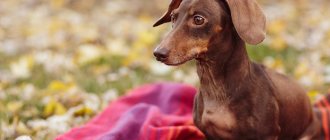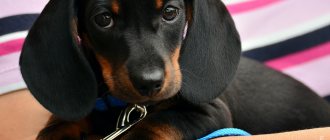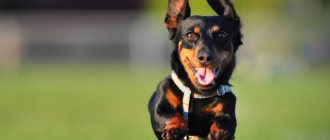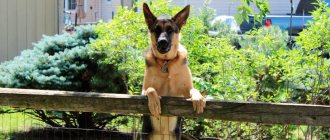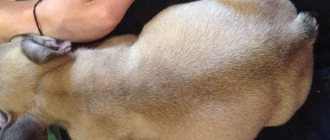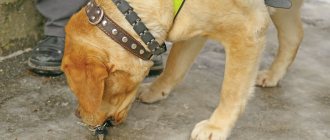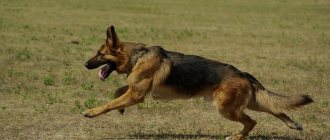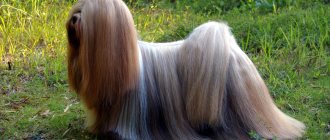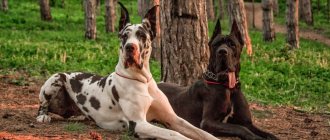Story
The dwarf dachshund has two ancestors - the dachshund and the pinscher. Breeders wanted to create a new breed of hunting dog. Tiny pursuers of game, due to their size, expend less energy, they are more nimble and crawl into tight animal holes. After several experiments, it was possible to achieve, in comparison with an ordinary dachshund, the appearance of a dog with miniature stature. But hunting genes did not work out. Then it was decided to crossbreed the smallest representatives of these breeds.
As a result, the breeders achieved what they wanted. A dwarf individual appeared before them. In the 19th century, the final standard for this breed was established in Germany.
Origin
The dachshund, regardless of its subspecies - standard or mini - is considered one of the oldest dogs. The breed was bred in ancient Egypt, and careful selection was carried out by German breeders in the Middle Ages. The original purpose of dachshunds was hunting - it has survived to this day, although now it is mainly a decorative pet.
The history of the dwarf pet began with standard brothers bred in Germany for the purpose of hunting burrowing animals. But these pets did not always fit in small passages and could not dodge wild animals in time, so hunters needed a small copy that would compensate for these shortcomings. Therefore, in the 1860s. Selection work began, headed by dog handler Engelman: a standard dachshund was crossed with a miniature pinscher. As a result, the breeders achieved the desired body parameters of the dog, but its working qualities were lost.
Engelman and his colleagues decided to solve the problem differently: he selected the smallest puppies from one litter and crossed them with each other. At the end of the 19th century, dog breeders managed to achieve the desired appearance of dogs, although small pets produced fewer puppies. The first standard for a dwarf pet was drawn up in 1880. The blood of wire-haired animals contains an admixture of terriers, as well as miniature pinscher, schnauzer and others.
Description of the dachshund
The appearance of the animal is quite original. The dwarf dachshund is similar to the regular dachshund. She has a playful, perky character, cheerful and cheerful. The elongated body on short legs gives the dog a comical appearance, but, like all dwarf breeds, it can stand up for itself, as well as for its owner. The miniature dachshund feels great in the house, but shows jealousy towards other four-legged and feathered animals if a person pays more attention to them.
Varieties
The small dachshund is classified by color, coat size and overall dimensions. There are options such as:
- smooth-haired;
- long-haired;
- wire-haired.
Based on color, animals are divided into:
- one-color;
- two-color;
- brindle;
- marble.
The color can be black, with red spots, brown, gradually turning into dark or brindle. Plain ones are divided into pure black and red, the color of dark clay. In breeds with long hair, the hair is wavy, not straight like a Yorkie, and covers the entire body rather than isolated areas. The smooth-haired dachshund has a glossy shimmer and is the easiest to care for.
Mini dachshunds are also classified by weight and chest volume. Unlike the usual one, the dwarf one has a volume of up to 35 cm. Rabbit individuals reach 30 cm in chest circumference, with a weight of up to 4 kg. Such representatives have now become exclusively ornamental animals.
Character and appearance
The structure of a miniature dachshund is the same as that of a regular one, with the exception of height and weight. The dog has an elongated body, short limbs, the front ones are smaller than the back ones. The chest is rounded below the knee. The forehead is clearly defined, smoothly turning into an elongated muzzle. The nose is black or brown. The eyes are dark or light brown, sometimes blue. The ears are large and folded. The back is powerful, the belly is drawn in. The tail is not docked, but is wrapped under the paws in the shape of a saber. The size of an adult dog at the withers is 21-16 cm, females are smaller - 14-19 cm. Weight does not exceed 6 kg.
This individual is a typical representative of hunting dogs and fits the description of a standard breed. The dog is stubborn, has a leadership character and will not tolerate other relatives on its territory. She has cunning and endurance.
Usually there are only 1-2 puppies in a dachshund litter, which makes breeding them a troublesome and very responsible task.
Expert opinion
Anna Abramenko
An avid dog lover. Experience in veterinary medicine since 2009.
Ask a Question
Dogs do not like loneliness and constantly need attention. If the owner ignores her, she may become uncontrollable, and out of longing for him, she will begin to tear furniture and slippers. Therefore, before you close her for the whole day, you need to give her more attention before leaving, play, walk and show your love in every possible way.
Education and training
Training begins from the first days the puppy is in the house. First you need to accustom him to a nickname; it should be short and memorable. At the same time, you should adapt the baby to his place, meal times and collar, show who is his owner.
Expert opinion
Anna Abramenko
An avid dog lover. Experience in veterinary medicine since 2009.
Ask a Question
To teach a dachshund hunting skills, you need to bait it with a piece of meat, place it close to the dog and say the command “search”.
It is also recommended to constantly use short instructions such as “fu”, “to me”, “place”, etc. At first, the dog will perceive them at home. Then it is recommended to move the lessons outside, where there are extraneous sounds, barking dogs and the noise of cars.
Expert opinion
Anna Abramenko
An avid dog lover. Experience in veterinary medicine since 2009.
Ask a Question
You can reward your dog for correctly following commands with treats, praise, and a calm tone.
When training a dachshund, it is forbidden to hit the dog or shout at it.
Training and education of a dwarf dachshund
A dwarf dachshund intended to be kept as a pet does not require special training. It is important to accustom her to several basic commands: “Fu”, “Come to me”, “Place”.
Animals that will be used for hunting undergo special training and field training . Dachshunds are very intelligent and quite flexible, but at times they can be stubborn. The trainer must act gently but persistently in order to achieve unquestioning obedience, but not to traumatize the dog’s psyche.
Care and maintenance
For smooth-haired representatives of the breed, it is enough to wipe them with a rubber glove so that the dead hairs fall off. It should not be bathed often - the fat secreted by the glands provides the short-haired species with additional warmth and microflora. After brushing the coat, the dog can be rubbed with jojoba or burdock oil.
Long-haired dogs need to brush their fur with a pet brush to prevent dust and mites brought in from the street from accumulating on it. It is recommended to trim the claws only of puppies; in adults they grind down on their own. Also a mandatory procedure is wiping the ears and eyes with a cotton swab dipped in warm water or chamomile decoction.
Expert opinion
Anna Abramenko
An avid dog lover. Experience in veterinary medicine since 2009.
Ask a Question
Dachshunds do not tolerate low temperatures well. Therefore, in winter they should be walked in overalls.
Before you start letting your puppy out of the house, you should take care of all the necessary vaccinations, especially against ticks. Even a smooth-haired dachshund can carry small parasites while walking in thick grass. It is also recommended to promptly treat your dog for worms and fleas.
Nutrition
It is recommended to feed puppies up to one year 4-5 times a day. For an adult dog, it is enough to give food twice a day, especially if it stays in an apartment. To make the coat shine, you can feed kelp and brewer's yeast.
You should not overfeed your decorative dachshund; it is prone to obesity. She should be protected from eating smoked and sweet treats, sausages, and high-percentage dairy products. If your dog suffers from a lack of vitamins during the off-season, you can add almond oil or ½ tsp to the diet. flax seeds.
This is interesting: The best dry food for dachshunds
You only need to feed your dog at certain times.
Expert opinion
Anna Abramenko
An avid dog lover. Experience in veterinary medicine since 2009.
Ask a Question
Snacks between meals should not be allowed. If there is food left on the plate, you need to remove it until next time.
Regime and diet
Mini-dachshunds are prone to obesity, so you need to be very careful about their diet. Animals should not be overfed. But lack of food can also lead to negative consequences.
If a dog owner has free time, it is preferable to feed the pet natural products. But you need to know that vitamins and minerals must be added to such a diet. This is required for balance. When preparing food, it is important to calculate the caloric content and energy value of foods.
The number of feedings depends on the age of the pet:
- puppies up to 4 months old should eat 5-6 times a day;
- from 4 to 8 months the number of feedings decreases to 3-4;
- adult dogs eat once or twice a day.
It is recommended to choose dry food after consultation with a veterinarian. It is convenient because the dog receives all the necessary vitamins and minerals.
Important! Mixing two types of food is strictly prohibited.
It is necessary to follow a meal schedule, it should be at the same time every day. If there is food left in the bowl, it should be removed.
Correct feeding regimen
Health and illness
During the development of the breed, the dwarf dachshund inherited some hereditary diseases and predispositions. Due to short legs and limited movement, they often suffer from obesity, which leads to diabetes and cardiovascular diseases.
Due to the difficult redistribution of weight, they experience displacement of the spinal discs. As a result, a nerve may be pinched, leading the dog to complete immobilization. To prevent this from happening, it is necessary to strengthen her paravertebral muscles, run up the stairs a lot with her, and carry a load on her back.
A dog can also inherit epilepsy. They also experience eye diseases and cataracts.
Life expectancy, illness and health
With proper care, dwarf dachshund dogs can live up to 15 years. The disadvantage of mini-dachshunds is that they often have health problems. The main ones:
- "swimmer's syndrome" In this state, puppies cannot raise their paws and only crawl;
- pinched spinal nerve, which leads to paralysis of the hind limbs;
- representatives of the breed often have an intervertebral disc defect, which also leads to paralysis;
- dogs are often prone to hypothermia and colds;
- “Acanthosis nigricans” is manifested by deepening of the skin and hair loss.
Other diseases that are common in the breed include urolithiasis and kidney failure.
Pros and cons of the breed
Advantages:
- Friendliness and enthusiasm. No matter what mood the owner is in, a cheerful appearance and kind eyes can cheer anyone up.
- High intelligence, allowing you to quickly master commands and remember your nickname.
- Get along with children.
- Bravery and the ability to stand up for a person in front of other relatives.
Flaws:
- tendency to diseases of the ears and spine;
- the embedded hunter gene will force the dachshund to dig up the garden;
- cocky character - the dog barks at all passing pets on a walk.
Advantages and disadvantages
Positive aspects of the breed:
- intelligence;
- communication skills;
- endurance;
- devotion;
- bravery;
- innate hunting qualities;
- good makings of a security guard;
- compactness;
- easy care (minimal shedding).
Negative sides:
- stubbornness and willfulness;
- touchiness;
- tendency to obesity;
- disobedience.
Rules for choosing a dachshund
When buying a dwarf dachshund puppy, you should be guided by one rule - the older the cub, the easier it is to determine its further development. Broods are sold from the age of three months, but it is better to choose a baby when he is 5-6 months old. During this period, dwarfism can be more accurately determined.
In appearance, the puppy should be well-fed, with shiny hair, without bald spots. It is worth paying attention to the teeth; the bite should be even, scissor-shaped.
Dogs with malocclusion are not allowed to hunt.
It is better to choose a puppy from a specialized nursery, where he will receive his first vaccinations.
Interesting facts from the life of dogs
- The first mention of a long dog with short legs was recorded in Ancient Egypt.
- The selection of modern representatives of the breed began in Germany in the 18th century.
- Despite their miniature size, dwarf dachshunds have strong muscles, which makes them hardy hunters.
- Due to its low stature, the animal is not afraid of the fox, which gives it an advantage in pursuing the animal.
- In Germany, the dog is unofficially called "Daxel".
- The name "Dachshund" means "earth dog".
Origin story
The first mentions of short dogs with a long body and short legs are found in Ancient Egypt. They became widely known and named in Germany, where specific traits were bred for the main purpose of persecuting small animals that live in burrows, such as foxes and badgers.
At the beginning of the 20th century, F. Engelman and a group of dachshund lovers set out to create a small dog that would replace the ferret in rabbit hunting. For this purpose, miniature pinschers were bred with ordinary dachshunds, but the offspring lost all hunting skills and were useless in this craft. A different tactic was chosen - crossing small adult purebred dachshunds and strict selection. The process was long and difficult, as small animals produced small litters. But the goal was achieved, and soon a variety appeared that retained the character of a hunter and the qualities of a successful catcher of rabbits and hares.
Reviews
Igor: “We got a dwarf dachshund on a summer cottage, and this beast set up a testing ground on the territory, making a bunch of holes. A very funny dog, when he frolics and runs around, he lifts his spirits and is inexpensive to feed.”
Oksana: “In my kennel, the dachshund does not like other dogs, she is only friends with her own, so we keep her away from everyone so that she does not attack. But when guests arrive, she is very friendly to people and asks to be held.”
Marina: “My dwarf dachshund is 8 years old. During this time, I treated her 2 times - for an ear parasite and had stomach upsets when she ate dry food at the same time. Since then, we only give her what we eat ourselves.”
Photo and video review
When buying a dwarf dachshund, a person expects to receive a sea of positivity and joy. And this will definitely happen, but it is worth remembering that this animal is not easy, and requires the same reverent attitude towards itself as to a child.
